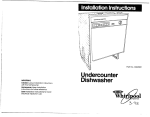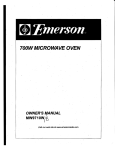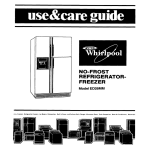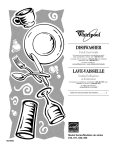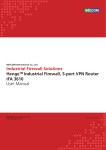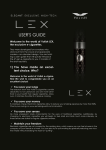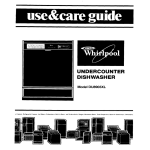Download Whirlpool DU4000XR Specifications
Transcript
-
UNDERCOUNTER
DISHWASHER
Model DU4000XR Series
-
-
Freezers
Relrlgeralor-Freezers
Ice Makers
DIshwashers
Built-In
Ovens
and Surtace
Units
Ranges.
Microwave
Ovens.
Trash Compactors
Room Air Candltmners.
Dehumldll
Contents
Page
BEFORE YOU USE YOUR DISHWASHER
IMPORTANT SAFETY INSTRUCTIONS
PARTS AND FEATURES
K)R BEST RESULTS
The Filtering System.
Quiet Operating Tips
PROPER LOADING
Top Rack Loading
Bottom Rack Loading
Silverware Basket Loading
ADDING DETERGENT
:
RINSE AID DISPENSER
BEFORE STARTING YOUR DISHWASHER
2
2
3
4
4
4
5
5
6
6
7
7
8
Page
STARTING YOUR DISHWASHER
HEATDRYorAIRDRY
To Add a Dish After Starting
Selecting a Cycle
Changing
a Setting
ENERGY SAVING TIPS
SPECIAL TIPS
1
COMMON DISHWASHING PROBLEMS
IF YOU NEED SERVICE OR ASSISTANCE
1. Before Calling for Assistance
2 If You Need Assistance
3. If You Need Service
4,lfYouHaveaProblem
,.
,:I.
B
B
B
9
9
10
11
12
14
14
14
j4
?4
d
c 1985 Whirlpool
Corporation
‘Tmk
Before you use your dishwasher
It Is your personal
responslblllty
and obligatlon
to be sure your dlshwasher:
Is installed by a qualified
installer.
l
Has been installed where it is protected
trom the elements.
l
Has been installed on a floor strong enough to support its weight.
l
Has been properly
connected
to electricity,
water and drain.l
Has been properly
electrically
grounded.l
Is not used by children or anyone unable to operate it properly.
l Is properly
maintained.
-See installation
instructions for complete
information
l
Parts and features
Model
DU4000XR
Series -
.I
UPPER SPRAY ARM
COLUMN
TOP RACK
BOTTOM RACK
c LOWER SPRAY ARM
RACK BUMPER
~LRwARE
i
1
DETERGENT DISPENSERS
BASKET
- MODEL AND SERIAL
NUMBER PLATE
:,(not
shown]
RINSE AID
DISPENSER
--
USIZK bulut
(Permanent
THE OVERFLOW
PROTECTOR is
desiqned
to prevent
too much water
from entering the
dishwasher, It Is not
removable.
Loualj
-
I
DOOR COLOR PANEL PACK
HEATING ELEMENT
/
(Screen
Copy
Model
-- your
-
and Serial
Numbers
When you need service or call with a questron,
have this information
ready:
1. Complete
Model and Serial Numbers (from the
plate located as shown).
2. Purchase date from sales slip.
Copy this information
in these spaces. Keep this
book, your warranty
and sales slip together
in a
handy place.
Please complete
and mail the Owner Registration Card furnished with this product.
1
and Removable
here...
Model
Senal
Number
Number
Purchase
Service
Date
Company
and
Telephone
Number
3
For Best Results
Your dishwasher
cleans by spraying
a mixture of hot, clean water and detergent
against
soiled surfaces
of dishes. When a cycle
is
started, the dishwosher
fills with waterto about
the level of the heating element
This water is
pumped
through
the rotating
spray arms,
drained
through
the filter system which removes
food and SOII, and pumped
back
through the rotating spray arms. Soiled water
is pumped
out and replaced
with clean water
during a cyclethe number of times depends
on the cycle being used.
Load dishes so soiled surfaces face
erful spray from rotating
arms.
pow-
aning filtering system and
removable
pump guard help eliminate
prerinsing by removing
food particles
from the
The filtering
system
It is not necessary
to rinse dishes before
putting them into the dishwasher.
Just remove
large pieces and quantities of food and bones.
The filtering system helps keep food particles
out of the wash water. Small particles are flushed
away as water is pumped
out. Larger particles
are trapped
in the pump guard
To remove the pump guard for cleaning.
1. Wait at least 20 minutes after a cycle for
the heating element to cool down.
2. Unload and remove the bottom rack
F
Cl
Water
must
3 Press the outslde wall of the pump guard at
the center to release the latch.
4 Lift out and rinse clean
To replace the pump guard..
I. Insert pump guard legs (on Inside wall] into
matching
openings
In filter screen.
2 Press down on outside wall until latch snaps
Into place
3 Replace
bottom ruck with rack bumpers
in
front
be hot
For best cleaning
and drying results, water should
140°F (60°C).
1. Turn on hot water faucet nearest the dishwasher.
until it is as hot as possible
2. Hold a candy or meat thermometer
in the stream
to measure the temperature.
3. If the temperature
IS too low, have a qualified
the water heater thermostat
setting.
be at least
Let water run
of hot water
person
raise
Check Water
Temperature
Quiet opemting tips
To avoid thumping and clattering
noises during
operation:
l Make
sure lightweight
load items are secured
in the rack.
l Make
sure pot lids and handles, pizza pans,
cookie sheets, etc. do not touch interior Walk
4
or Interfere
with either of the spray arms
rotation.
l Load
dishes so they don’t touch one another.
NOTE: Keep sink drain plugs inserted
during
dlshwasher
operation
to prevent noise transfer through dralns.
Proper loading
Always load dishes so soiled surfacesare
Water must be able to drain off completely
items so spray can reach all surfaces.
reached by spray from rotating
for best drying results. Be careful
spray arms,
to separate
Top rack loading
The top rack is designed
for CUPS, glasseS
and smaller items.
. Place so open ends face down for cleaning and draining.
. load glasses in top rack only. Bottom
rack is not designed
for glasses. Damage
may occur.
I
l
l
l
l
l
Place items in the rows between
prongs.
Placing them over the prongs can lead
to breakage.
Be sure lightweight
items are held firmly
in place.
China, crystal and other delicate
items
must not touch each other during dishwasher operation.
Damage
may occur.
MIXED LOAD
Load plastic items only in the top rack.
Only plastic
items marked
“dishwasher
safe” are recommended.
Plastic items can be melted in the bottom
rack.
‘Items
with cooked-on
soiled surfaces facing
or dried-on
the spray
foods
l
Small bowls, pans and other utensils can
be placed
in the top rack.
should
be loaded
in the bottom
rack with
Bottom
rack
loading
Silverware
basket
loading
Load forks and spoons so they don’t
nest together. Spray can’t reach nested
Items
-,?,.
N
l
l
l
Make sure pot handles and other items
do not stop rotation of either the upper or
lower spray arm. Spray arms must move
freely.
Securely place heavily soiled cookware
face down in rack.
Place plates, soup bowls, etc., between
prongs and facing the spray.
YES
MIX Items in each section of the basket Small Items - baby bottle caps, jar
lids, etc -can
be put in any section.
Make sure sharp Items (knives, forks
skewers, etc.) are put In pornt down
The silverware
basket can be loaded
while It’s In place on the door, or it can
be taken out for loading
on the counter
or table
It can also be removed
for easy unloadrng. Always unload or remove the
basket before unloading
the racks to
avold
spilling
water droplets
on the
To remove the basket, slide it toward
the top o! the door - by the handle. Lift
it off the holding
buttons. Replace
it in
reverse order
l
Load cookie sheets, cake pans and other
large items at sides or back. Loading
such items in front may keep water spray
from reaching
detergent
dispenser
and
silverware
basket.
NOTE:
Do not load glasses, cups or plastic items
in the bottom rack.
a When lower rack is removed,
replCICe
with bumpers in front.
l
6
To open the basket,
as shown. Be sure t
cover is complete
latched
before
pulling out the
bottom rack and
before closing
the dishwasher
door.
unhook
the latch
Adding detergent
The kind and amount of dishwasher
detergent
you use is an important
getting your dishes clean. Read this section carefully.
Use automatic
dlshwasher detergent
only.
Other detergents
are
too mild and much too
sudsy
to work
in the
dishwasher.
Different
brands
of
dishwasher
detergent
have different
amounts
of phosphorus.
Phosphorus softens
water
and
helps
prevent
water
spots on dishes.
If water
is hard and
phosphorus
content
is
low (8.7% or less), you
may need to use more
detergent
or use a
brand
with a higher
phosphorus
content
[12% or higher).
The detergent
part of
dispenser
The detergent
dispenser has one section with
a cover and one without
l
Put detergent
in both sections for cycles with
two washes.
l
Put detergent
in the covered
section only for
cycles with one wash.
l
Push the cover down
until it is latched.
The cover opens automatically
when the main
wash starts. Detergent
in
the open section
falls
into the dishwasher
when the door is closed.
-
Do not add detergent
until you are ready to
wash. Fresh automatic
dlshwasher
detergent
Is necessary
for best
washing
results.
Store
detergent
tightly
in a
cool dry place.
Use covered
section for...
NORMAL WASH Cycle
How much detergent
v Use both
sections for..
POTS & PANS Cycle
HEAVY WASH Cycle
to use
The amount of detergent
to use
depends
on the hardness of your
water. If too lrttle is used, dishes won’t
be clean. However, if too much is
used in soft water, glassware
will
begin to etch.
Find out your water’s hardness by
asking
your local water department, water softener company
or
county extension
agent.
l
l
l
HARD-Fill
1 or both sections to lop
line if water is 8 or more grains of
hardness.
MEDIUM - Fill 1 or both sections to
middle line if water is 5 to 7 grains of
SOFT - Fill 1 or both sections to
bottom
line if water is 0 to 4 grains
hardness.
of
Rinse aid dispenser
A rinse aid helps keep water from forming droplets and drying as spots. Keep the dispenser
filled with a rinse aid such as
Jet-Dry@A small amount is released
automatically
during the
final rinse of each cycle. Check the dispenser
periodically
to
see if it needs refilling.
Keep the dispenser
fill cap tightly closed.
Before starting
your dishwasher
1. Spin the Upper Spray Arm to make sure
nothing will stop it from turning freely
2. Push door firmly when closing and it will
automatically
latch.
3. Run hot water at sink nearest dishwasher
until it is hot. Turn it off.
Starting your dishwasher
.#
CLEANSELECTORBUlTONS
POTS & PANS cycle...
NORMAL WASH cycle...
1. Push POTS& PANSClean Selector Button.
2. Push button for option desired.
3. Turn Cycle Control Knob clockwise to
dot marked POTS& PANS.
- POTS% PANS and NORMAL WASH Cycles share the same spot on the dial.
The Clean Selector Button determines
which cycle operates.
The dishwasher will automatically
start
that cycle.
1. Push NORMAL WASH Clean Selector
Button.
2. Push button for option desired.
3. Turn Cycle Control Knob clockwise to
dot marked NORMAL WASH.
- NORMAL WASH and POTS% PANS Cycles share the same spot on the dial.
The Clean Selector Button determines
which cycle operates.
The dishwasher will automatically
start
that cycle.
LIGHT WASH cycle...
1. Push LIGHTWASHClean Selector Button.
-LIGHT WASHand NORMAL WASHCycles
share the same Clean Selector Button.
The Control Knob setting determines
which cycle operates.
2. Push button for option desired.
3. Turn Cycle Control Knob clockwise to
dot marked LIGHTWASH.The dishwasher
will automatlcally start that cycle.
HEAT DRY or AIR DRY?
RINSE & HOLD cycle...
1. Push NORMAL WASH Clean Selector
Button.
2. Select AIR DRY Option only.
3. Turn Cycle Control Knob clockwise to
dot marked RINSE % HOLD. The dishwasher will automatically
start that
cycle.
If the HEAT DRY Option is selected, air in the
dishwasher
is heated during the “dry” part of
the cycle.
save energy, but dishes take longerto dry (overnight] and-some
water spotting
may- result.
Some items (such as plastics] may need towel
drying.
If the AIR DRY Option is selected, air in the
dishwasher is not heated. Using this option helps
For best results, use a liquid
Jet-Dr)F
To add a dish after starting
1. To be sure the added
item is washed and
rinsed, make sure the Cycle Control Knob
has not passed LIGHT WASH.
2. Push up on door latch to unlatch door and
stop the cycle.
3. Open the door and add the dish.
rinse aid such as
4. Close the door. Do not latch it. Wait 30 seconds for air in the dishwasher to warm up. This
helps reduce the amountof moisture thatcan
come from the vent when restarting
the
cycle.
5. Press in door to latch it. The dishwasher
will
start where it stopped.
-I
OPTION SELECTOR
BUllONS
Selecting
DOOR LATCH
CYCLECONTROLKNOB
a cycle
POTS & PANS Cycle
Maximum
cleaning
for cookedor
baked-on
foods. Timer delays while
the dishwasher automatically
heats
the water to 145’F (63°C) in both
washes and the last rinse (marked ‘1,
Cycle time will be about 1% to 2
hours, depending
on time needed
to heat water.
NORMAL WASH Cycle
A double wash for normal to heavily
soiled
loads. (The Energy Guide
Label data is based on this cycle.)
Cycle time is about 60 minutes.
LIGHT WASH Cycle
For normal, everyday
soiled loads.
Cycle time is about 60 minutes.
RINSE & HOLD Cycle
For rinsing a few items to be washed
one or more days later. Cycle time
is about 10 minutes.
Use AIR DRY only.
Changing a setting
You can change
a setting anytime
during
any cycle.
1. Press in the door latch to unlatch the door
and stop the cycle.
2. Turn the Cycle Control Knob clockwise
to the
cycle you want.
3. Be sure the detergent
dispensers
are filled
properly
for the new cycle.
4. Close and latch the door. The dishwasher will
automatically
start the new cycle.
9
Energy saving tips
You can help save energy
if you:
1. Wash full loads. Running a half-filled
drshwasher uses the same amount of electricity
and hot water as a fully loaded machine.
2. Use the LIGHT WASH Cycle
for normally
soiled loads. It uses less hot water and energy
than other wash cycles.
3. Air dry dishes
drying
cycle
(overnight]
4. Load correctly
for best washing
results. Incorrect loading
may cause poor washing
and the need to rewash all or part of the
load
when you don’t need a rapid
Allow longer
drying
times
5. Don’t pre-rinse
normally
soiled dishes. Select the correct cycle for the load and use
the recommended
amount of detergent
for
good washing results without hand rinsing.
6. Use your dishwasher
during off-peak hours.
Local utilities
recommend
this to avoid
heavy usage of energy at certain times of
day
7. Kitchen cleanup
can be done quickly and
efficiently through the use of your dishwasher.
Most appliance
parts that can fit in the dishwasher can be cleaned
by it. Burned-on soil,
however, should be cleaned
by hand.
10
Special tips on dishwasher use
Remember,
use your dishwasher
only for the job it was designed
to do.
Some items are not dishwasher
safe or may require special care.
Read these special tips for the following
items:
hUlliUUlTl:
Aluminum loses its bright, shiny appearance
and darkens in color due to
minerals in the water and the alkalinity of the dishwasher detergent. Colored aluminum may
fade
TIPS: If washed in the dishwasher
avoid placing directly in front of detergent
dispenser
where it could be sprinkled with undissolved
detergent,
causing spotting, pitting, and
discoloration
Follow utensil manufacturers’
Cleaning inStrUCtiOnS.
China: Hand-painted, metal-trimmed, and antique china may fade due to high water
temperatures
and alkaline detergent
solution in the dishwasher.
TIPS: Delicate,
antique items should not be washed in the dishwasher.
Load carefully.
Do not allow pieces to touch each other. Test one piece by washing
it daily in the
dishwasher for several weeks. Then compare
it with the rest of the set to see if colors have
changed
crystal
and decorative glasses:
Crystal can break from sudden exposure to high
water temperature.
Metal trim and colorful decoration
on glass will fade in time when
washed in the dishwasher
TIPS: Delicate,
antique items should not be washed in the dishwasher.
Load carefully
in top rack only. Be sure to load a few larger items in the bottom rack to reduce amount of
force of water spray reaching glassware
from lower spray arm. Use the shortest cycle.
Flatware:
Salty and acidic foods may tarnish silver and stainless flatware if allowed to
remain on the utensils. A film may form on sterling silver and silver plate items washed in a
dishwasher
This film is caused by reaction of silver with chlorine
in the detergent.
Gold
flatware
is not dishwasher
safe.
TIPS: Rinse flatware as soon as possible, especially
if it is not to be washed right away.
Dishwasher detergent
may remove antique finishes. Wash by hand. Tarnish and film
build-up can be removed with silver polish.
Cast
irOIl
UtCUSik:
will result.
TIPS: Wash by hand
hour or two.
The seasoned
To re-season,
finish will be removed
coat with unsalted
PhtiCS:
Many plastics will have “Dishwasher
heat sensitive and may melt or warp
TIPS: If In doubt, try one piece
additional
protection.
Place
in upper
in the dishwasher.
fat and heat in a slow oven for an
Safe” written
on them. Some plastics
rack only. AIR DRY option
Non-stick finish
UtCUSilS:
Most can be washed
TIPS: Follow manufacturers’
suggestions
Rusting
are
provides
in the dishwasher.
Wood:
Many wooden items will crack and warp or lose their finish.
TIPS: Do not wash cutting boards, wooden salad bowls or knives
dles in the dishwasher.
Pewter
with wooden
Or pewter-like
materials: May streak, discolor, and pit.
TIPS: To keep pewter at its very best, hand wash with mild detergent.
Dishwasher care & cleaning:
Exterior - Regular use of a sofi damp cloth or sponge
and a mild detergent is all that is necessary, in most cases,
to keep the outside of your dishwasher nice looking and
clean Interior - Hard water minerals rnay cause a
white film to build-up on the inside surfaces,
especially
just beneath the door area.
Wear rubber gloves when cleaning
the dishwasher interior. Do not use
any type of cleanser
other than
dishwasher
detergent
because
it may cause foaming or
sudsing.
han-
Common dishwashing problems
PROBLEM
CAUSED BY
SOLUTION
Spottlng
and
fllmlng
(hard water film]
Hard water
Fill detergent
tergent with
be necessary
To remove
dispensers
to capactty
Use dishwasher
highest avallable
phosphorus
content.
to install water softener.
spots and ftlm, try a vinegar
deMay
nrtse...
1 Wash and rinse load as usual. Use AIR DRY.
2 Remove all metal items.
3 Put 2 cups (500 ml] white vinegar In a container
on the
bottom rack.
4 Run dishwasher
through a complete
washing
cycle
Water IS not
hot enough
Water temperature
should be at least 140°F (60°C). Set
water heater thermostat
to a higher setting
Run water at
srnk unth hot before
starting
Not enough
detergent,
or
Improper
detergent
“Old” detergent
Use more dishwasher
detergent.
Use detergent
est ovaltable
phosphorus
content
.especially
water
Improper
loading
No rinse aid
AIR DRY Setting
Spray arm or arms not
rotating freely
“0ld”detergent
Small partlcler
deposlted
on
Items
Dlshes
not dry
Chlpplng
breaklng
glassware
12
or
on
Use only fresh dishwasher
detergent.
Store tightly
container,
in cool, dry place. Discard old detergent.
fill dispensers
until ready to start dishwasher.
closed
Do not
Make sure dishes and glassware
are loaded
so spray
reaches all surfaces and items drain properly.
Do not overload. Do not nest Items
Make sure large items do not block spray from reaching
detergent
dispensers.
Does the rinse old dispenser
need filling? See instructions
on page 7
Drying without heat may result in some spotting of glasses
and silver
Check spray arms to make sure they turn freely after
ing Be sure a utensrl has not prevented
therrturning.
Use only fresh dlshwasher
detergent.
Store tightly
container,
In cool, dry place. Discard old detergent.
fill dispensers
until ready to start dishwasher.
loadclosed
Do not
Not enough
detergent,
or
improper
detergent
Use more dishwasher
detergent
Use detergent
est available
phosphorus
content.
.especiallY
water
Water
enough
Water temperature
should
be at least 140LF (60°C). Set
water heater thermostat
to a higher setting. Run water at
sink until hot before
starting.
IS
not hot
with hrghwith hard
Water pressure may
be low, dishwasher
is
not filling properly
If water pressure
whtle dishwasher
Water is not hot
enough
Water temperature
should be at least 140°F [6O”C). Set
water heater thermostat
to a higher setting. Run waler at
srnk until hot before
starting.
Improper
Make sure dishes and glassware
are loaded
reaches all surfaces and items drain properly.
erload
Do not nest items
loading
No rinse old
AIR DRY Setting
Black marks
dlshes
used
with high.
with hard
used
is low, do not use water for other purposes
IS running
(to assure correct fills).
Fill rinse old dispenser.
Allow more time when using AIR DRY Option,
DRY. Plastic items may need towel drying.
so spray
Do not ov-
or use HEAT
Aluminum
utensils
rubbing
against items
during washing
Use care In loadlng
alumlnum
utensils,
llghtwelght
loll container.
Place so they
dlshes.
Remove
black marks with plastic
and a mild abrasive
cleanser.
Improper
Do not overload
Load glasses in the top rack only. Load
between
prongs,
not over them. Glasses
loaded
over
prongs WIII not be supported
and may chip or break.
loading
especially
a
do not touch
scouring
pad
PROBLEM
CAUSED
Dlshes not
washlng clean
Water is not
hot enough
BY
SOLUTION
Water tenoeroture
should be at least 140 F 160 CI Set
water heaier thermostat
to a higher setting
R;n waier ut
sink until hot before
starting.
Improper
Make sure dlsrles and glcssware
are loaded
reaches ~~11surfaces arid Items craln properly
erload
Do not lest llerns
loading
Make sure large Items d..>
detergent
dispensers
Spray arm or arms not
rotating freeiy
Not enough detergent
or improper
detergent
“0ld“detergent
Water pressure may
be low, dishwasher
IS
not filling properly
Cloudy
tllm on
glassware,
etching
permanent
corrosion
Too much detergent
in soft water
Dishes 6
lnterlor of
dlshwasher
yellow or
brown
Iron or manganese
water
Inadequate
:,a1
k sprcv
Sic;
so spray
Do not OL-
Vom reaching
Check spray urms to make su,e they tJrn ‘:eely after IcaaIng Be sure a utensil has not preventea
thelrturnlnq
Use more dlshwasher
detergeqf
Use detergent
with highest avollzble
phosphorus
content
especially
with nard
water
Use only fresh dishwasher
derergenr
Store tightly closed
container,
in cool, d:y plr~ce Dlscard old de:ergent
Do not
fill dispensers
until ready to star! dishwasher.
if water pressule 1s low, do not use water ror other purposes
while dlshwasher
IS running 1’0 assure correct fillsj
Check for rainbow
hue on glasses
A rainbow
hue Is the
first sign of etching [corrosion
of glass; Reduce the amount
of dishwasher
detergent
!)sr7 a de!ergenr
with a lower
phosphorus
confent
If water pressure is iow a1) not use tiater for ‘other purposes
orret;: water tills]
while dlsnwasher
:s running (tc (assure
Make sure dishes and glassware
are loadea
properly
to
assure adequate
rI?sir,u ond drainirlu
Co not overload
rinsing
in
Temporary
remedy:
1 Set empty dlshwast;er
fcr ii ‘one wash ‘c’, clc
2 Start dlshwasher
aria .~rilatcn a~~o’t> stop it when It has
fliled for the wasn c:c;rb of the c ‘,;zle
3 Add’.to’,
Cup (121; to 240 ml.] of cilrlc nc:ld crvstuis
iilsually
ava!lable
in drdgstoresj
4 Close and latch 3oo~:o romr:!ete
cycle
Permanent
solution:
Installi an Nrorl or manga,;ese
‘I!ter to
home water supply
Rinse flatware
that IS lo stend !cr several
washing
[use Rinse 5: Ho!~; Clecr: stained
polish and re Nash Do not put stalnless
tlatware
In the same sllverware
basket
Direct contact
between
these metals can
nent damage
to the sliver.
Rust spots on
stalnless
steel
-ORDark spots on
flatware
stalnless
steel,
sliver plate, or
sterllng
Allowing
salty or
acidic
foods such as
mayonnaise,
vinegar,
fruit juices, salad
dressings, milk
products
to remain on
flatware
Undissolved
detergent
coming in
contact with flatware
Bronze tarnish
on silverplate
Silverplate
IS worn off
Exposed base metal
to kes on a bronzed
hue
Remove
Water lett in
bottom of
dlshwasher
Dishwasher
cycle not
completed
Clogged
drain air
gap
Allow
Remove spots with silver polish
detergent
on wet flatware
tarnish
dishwasher
witn silver
volish
to complete
hours before
items with silver
steel and sliver
compartment.
cause perma-
Avoid s;J’lllng
concentrated
Have sl!ver repiated
cycie
Some plumbing
codes require (use ot CI drain air gop between an undercounter
a’shwasher
c11nathe drain system
of the house The air gap IS usually located
above :he sink
or on the top ot the counter near the dtsnwasher
to prevent
the possibility
of water hacKing
up from tne drain into the
dishwasher
due 10 o plugged
drain The drain air gap IS
NOT a part of the dlshwasher
ond IS NOT covered
by the
dishwasher
warroniy
me Arain otr gap should be kept
clean to insure proper ii,:f3ir;lncj
01 the dishwasher
13
If you need service or assistance, we suggest
you follow these four steps:
1. Before
calling for assistance...
Performance
problems often result from little
things you can find and fix yourself without tools
of any kind.
If your dishwasher
will not run, or stops during
a cycle:
l Is the
door tightly
closed
and securely
latched?
l Has the
cycle been correctly
set?
l Is the water
turned on?
l Have
you checked
your home’s main fuses or
circuit breaker box?
l Is the dishwasher
wired Into a live circuit with
the proper voltage (undercounter
models)?
l If the motor
has stopped because of an overload, it will automatically
reset itself within a
few minutes. If the motor does not start, call for
service.
If your dlshwasher
seems to run too long:
l Are you
using POTS & PANS Cycle? The
dishwasher
may be waiting for the water
to heat.
l Is your
household
water temperature
set too
low? Low water temperature
settings
will
cause longer dishwasher operating
times.
3.
If you need service*...
Whirlpool
has a
nationwide
network of franchised
warranty
service,
anywhere
in the United States, To locate TECHCARE service in your area, call our COOL-LINE
service assistance telephone
number (see Step
2) or look in your telephone
directory
Yellow
Pages under:
APPLIANCES-HOUSEHOLDMAJOR-SERVICE
(L REPAIR
WHIRLPOOL APPLIANCES
FRANCHISEDTECH
CARESERVICE
SEKI'I~
XYLSERVICECO
123 MAPLE
detergent
(The rack
2. If you need assistance*...
Call Whirlpool
COOL-LINE”
service
assistance telephone
number. Dial free from:
Continental
U.S. . . . . . . . . . . (800) 253-1301
Michigan
. . . . . . . . . . . . . . . . . (800) 632-2243
Alaska & Hawaii
. . . . . . . . . (800) 253-1121
and talk with one of our trained Consultants. The
Consultant can instruct you in how to obtain satisfactory operation
from your appliance
or, if
service is necessary,
recommend
a qualified
service company
in your area.
14
E C‘OMPA
WHIRLPOOL APPLIANCES
FRANCHISEDTECH-CARE
SEXI’IC‘E
\I,?.\
XYZSERVICE
123MAPLE
999.9999
SERVICE
('Od41!4NIES
CO
999 9999
OR
WASHING
MACHINES,
DRYERS
& IRONERS-SERVICING
WHIRLPOOL APPLIANCES
F9ANCHISEDTECH
CARESERV!CE
If water remains in the dishwasher:
l Has the cycle
completed?
l A small
amount of remaining
water is normal.
l
Is drain air gap clogged?
If detergent
remains in the covered
cup:
l Is the
bottom rack in backwards?
bumpers should be at the front.]
l Is the dishwasher
detergent fresh?
l Is the cycle
completed?
ELECTRICAL
APPLIANCESMAJOR - REPAIRING
L PARTS
OR
SEXI’l(‘E
XYZSERVICE CO
'23 MAPLE
(‘o.MPA‘vIES
999 9999
4. If you have a problem*...
Call our COOL-LINE service assistance
telephone number (see Step 2) and talk with one of
our Consultants, or if you prefer, write to:
Mr. Robert Stanley
Division Vice President
Whirlpool Corporation
2000 US-33, North
Benton Harbor, Ml 49022
*If you must call or write, please provide: model
number, serial number, date of purchase, and a
complete
description
of the problem. This information is needed in order to better respond to
your request for assistance.
FSP is a registered
trademark
of Whirlpool
Corporation
for
quality parts. Look for this
symbol of quality whenever
FSP
you need a replacement
part
8 for your Whirlpool
appliance.
FSP replacement
parts
will fit right and work right, because
they are
made to the some exacting
specifications
used to build every new Whirlpool
appliance.
0
For visually impaired consumers
If you need large type, Braille, or audio cassette versions of Use and Care literature in order
to use this appliance,
please write to:
Literature Department
Whirlpool Corporation
LaPor-te Division
1900 Whirlpool Drive
LaPorte. IN 46350
Select one of the following materials:
Audio Cassette
Use & Care
Kit 787478
literature
Braille Use & Care literature
Kit 787476
“Large Type” Use & Care
Klt 787477
literature
Send your name, mailing address plus the
model and serial number for your Whirlpool appliance
to the address shown above. We will
send the kit you select at no charge.
Making
your world a little easier.
PartNo.304275Rev.A
al986 Whirlpool Corporation
Makers.
Dishwashers
Bu~ltbln
Ovens
and Surface
Un11s Ranges
Printed in U.S.A.
M~croware
Ovens
Trash Compactors,
Room Air Condltloners.
Oehumldlflers.
Automatic
Washers,
Clothes
Or)
















